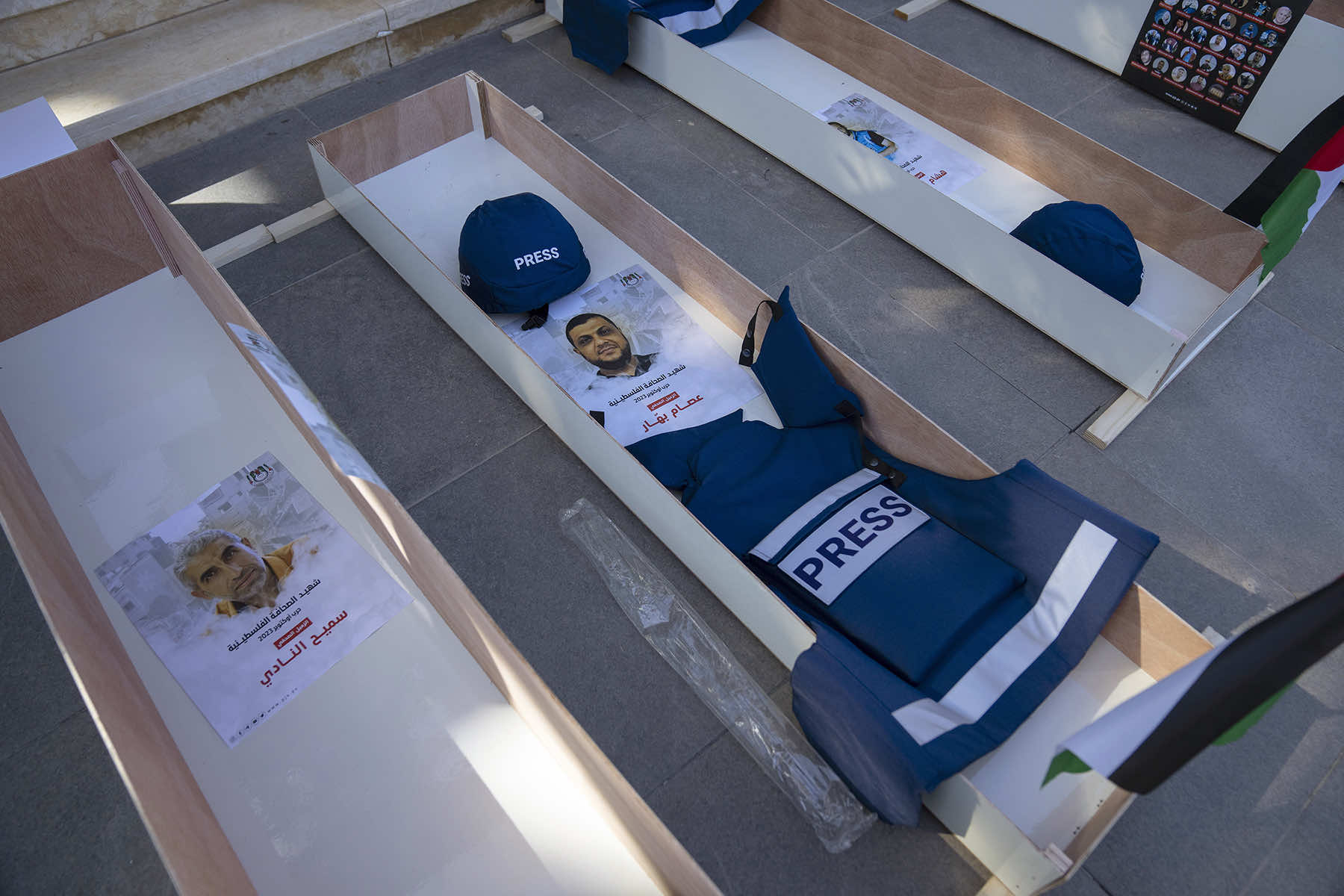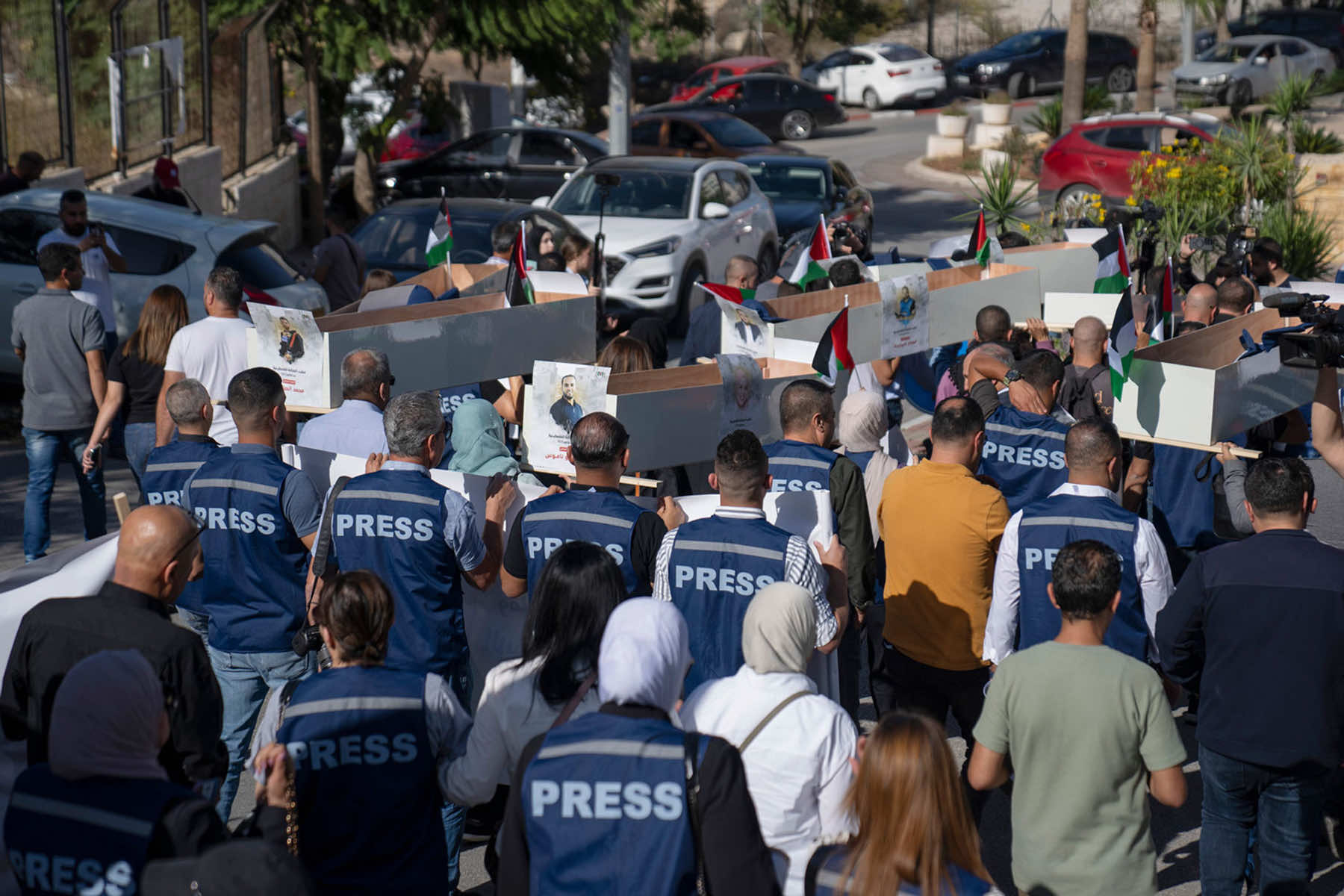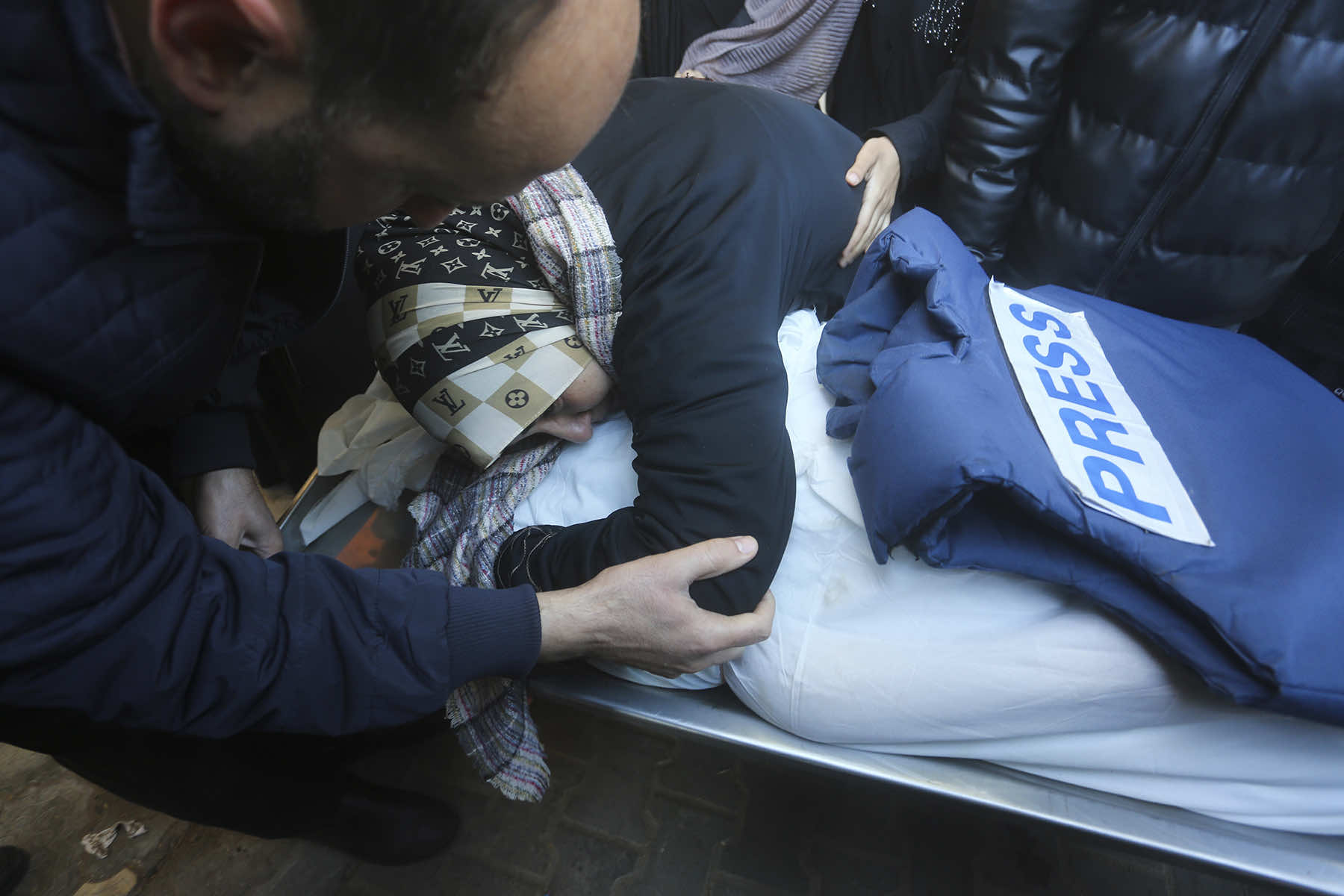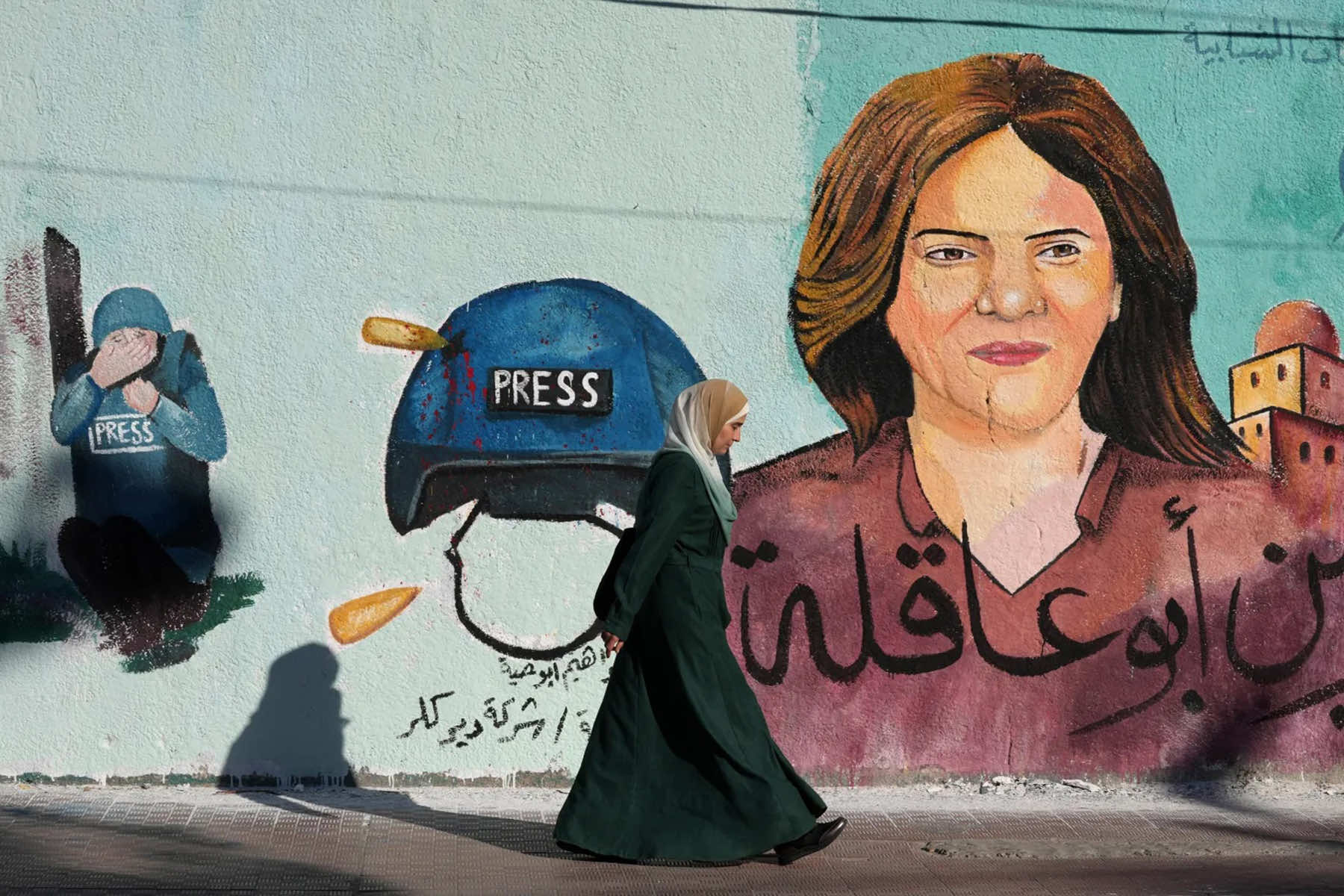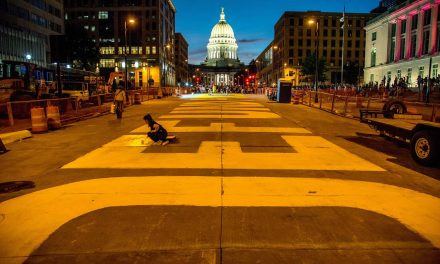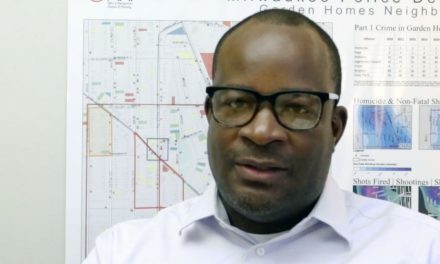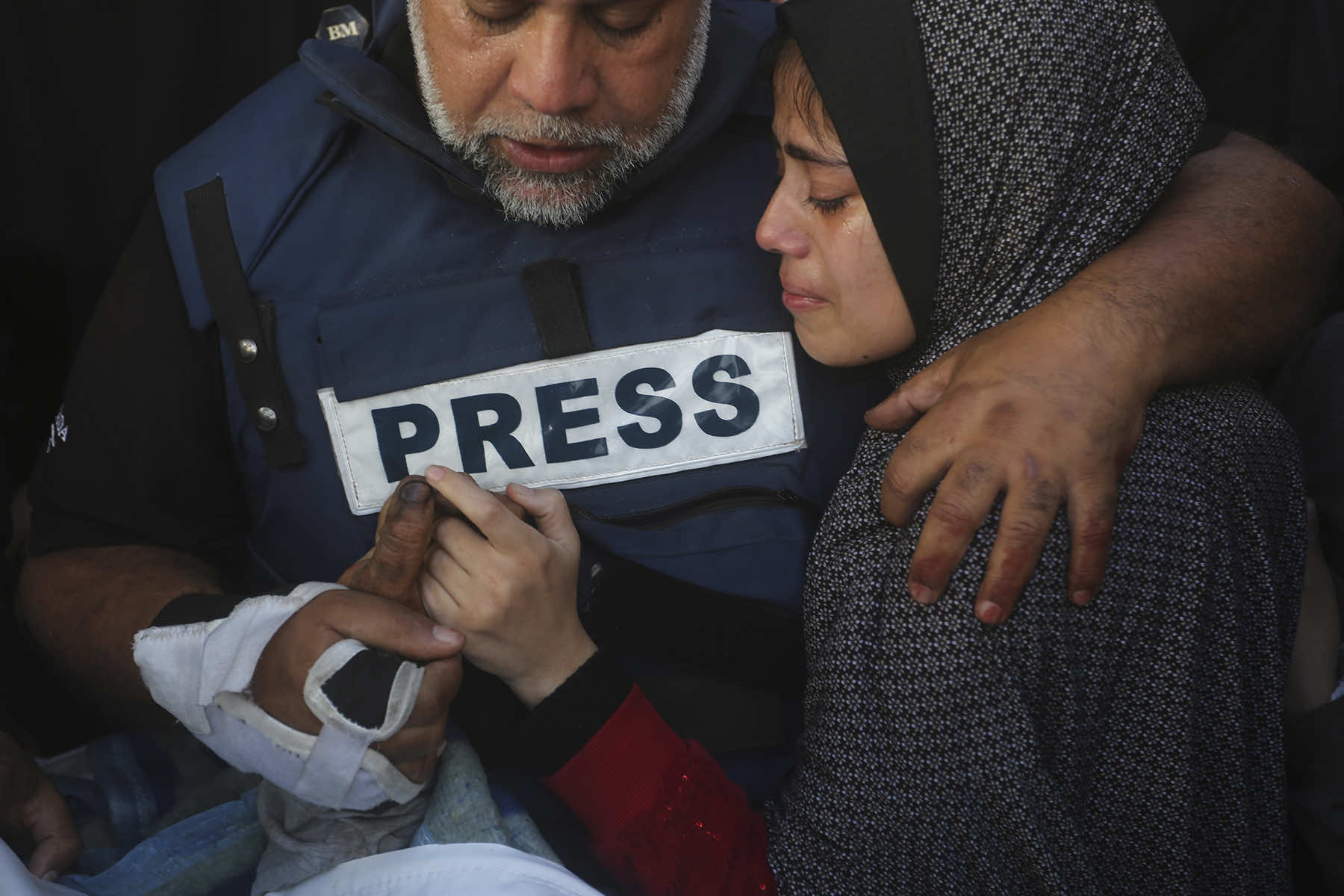
Being a Palestinian journalist has never been easy, but Israel’s escalation of violence against members of the press in Gaza is unprecedented, according to press freedom advocates. While global solidarity has offered some help to those documenting events in the field, their efforts remain overshadowed by increasing danger and continued bloodshed.
Gaza is the deadliest place on Earth to be a journalist today. More than 100 journalists and media workers have been killed in Israeli airstrikes on their homes or vehicles or in attacks by invading Israeli forces since early October 2023, according to the Palestinian Journalists’ Syndicate.
The attacks are part of Israel’s war on the Gaza Strip, an occupied and besieged territory in southern Palestine on the eastern Mediterranean coast. Neither Palestine nor the governorates that comprise the Gaza Strip—which is only about the size of Philadelphia, Pennsylvania—have a land army, air force, or navy to fight a war.
Experts have described the assault on Gaza as ethnic cleansing and genocide and accused Israel of committing international crimes. In early January, the International Court of Justice heard opening arguments in a case brought by South Africa accusing Israel of committing the crime of genocide in Gaza.
According to the 2023 annual report of the Palestinian Journalists’ Syndicate (PJS), Israel killed 102 journalists and media workers in Gaza between October 7 and December 31, 2023. PJS’s report also documented more than a thousand violations against journalists across Palestine, including the West Bank, Gaza, Jerusalem, and the 1948 occupied territories. Reuters journalist Issam Abdallah was also killed by Israeli tank shelling in southern Lebanon on October 13, 2023.
There were about 1,000 Palestinian journalists working in Gaza when Israel launched its assault on the territory last October. Israel controls movement into Gaza and has barred foreign reporters from entering. A limited number of international journalists have been embedded with the Israeli military since it launched its offensive, but they are forbidden from contacting Palestinians, and Israel requires their reports to be reviewed before publication or broadcast.
While international media organizations have challenged the ban, Israel’s Supreme Court upheld it last week. “The news has to be reported by Palestinian journalists. Otherwise, no one will know what’s going on,” said Rania Khayyat, communications officer at PJS. “It is a very heavy duty.”
With over 100 journalists in Gaza now killed, the mortality rate for journalists in the territory exceeds those of American combat soldiers in the Vietnam War, the Korean War, or World War II.
Organizations such as Amnesty International, Human Rights Watch, and the Committee to Protect Journalists (CPJ) have specifically called for investigations into the killings of journalists. “Journalists are civilians and must be treated as such under international humanitarian law,” said Sherif Mansour, the Middle East and North Africa program coordinator at CPJ, in a recent statement. He added that Israel’s assault on Gaza is “the most dangerous situation for journalists we [at CPJ] have ever seen.”
Palestinian journalists say the support they have received from organizations such as CPJ and the International Federation of Journalists (IFJ) has been a boon during the most horrific period of violence and suppression in living memory. “If there is a bright side, the bright side is being surrounded by good people who believe in us,” said Khayyat.
Material support from various organizations and initiatives has helped Palestinian journalists continue their work in near impossible conditions over the last several months. For example, when damaged communications infrastructure in Gaza began to fail last October, Egyptian journalist Mirna El Helbawi launched eSims for Gaza.
The initiative offers virtual SIM cards to help Palestinians stay connected amid communications blackouts. Initially, the effort prioritized journalists and media workers and then pivoted to a broader group, providing more than 100,000 eSims to Gazans. Disabled writers and activists in the United States launched a similar initiative called Crips for eSims for Gaza in December.
The IFJ has worked closely with PJS, raising money through the IFJ Safety Fund, which the PJS has used to purchase vital supplies for journalists in Gaza, including batteries, clothes, food, first-aid kits, and blast trauma packs.
The supplies have had a real-world impact. “It was humbling to learn … that Gazan photographer Mohammad Baalousha saved his own life with a blast trauma pack that the IFJ helped supply, after snipers shot him twice in the legs,” said Tim Dawson, IFJ’s deputy general secretary, in a recent statement.
Baalousha told The Washington Post that he was shot by an Israeli sniper on December 16, 2023, less than three weeks after he broke the story that at least four premature babies had been abandoned to die and their bodies left to decompose in an intensive care unit at al-Nasr Children’s Hospital when Israeli troops forced hospital staff to evacuate.
Although critical support has reached Palestinian journalists, Khayyat emphasizes there is still significant work to be done to ensure media workers in the country can do their jobs without fear of reprisal. For those in Gaza, the path toward this future will be even more difficult as Israel’s assault has left more than 1.9 million Gazans internally displaced and killed more than 22,000.
Like so many Gazans, dozens of media workers have lost their homes and members of their families. Over 70 press offices, more than 350 schools, and “almost all universities” in Gaza have been damaged or destroyed in Israeli attacks.
Injured reporters, including Baalousha, cannot access needed health care because Israeli attacks have destroyed much of Gaza’s health infrastructure. An Instagram reel posted on Dec. 31, 2023, showed that Baalousha was trapped in a location he crawled to after being shot. With no ambulance able to reach him, he was forced to treat his own injury using makeshift supplies.
While Palestinians face this latest Israeli onslaught, people of all faiths and backgrounds worldwide have come together to show solidarity for Palestine and call for an end to the aggression. Demonstrations in cities like London and New York have drawn tens of thousands of supporters. Several vigils for slain media and culture workers have also been held over the last few months.
Khayyat said these demonstrations of solidarity and mourning have helped spread the message that journalism is under attack in Palestine and the targeting of journalists must be condemned and investigated. “We are impressed seeing the demonstrations in big cities all over the world,” she said. “This is very important, and we need it to continue.”
When raising awareness of the plight of Palestinian journalists, Khayyat said it is important to situate it within what the CPJ has called a “deadly, decades-long pattern.” “Being a Palestinian journalist has always been hard,” said Khayyat.
Over the last five years, Khayyat said the PJS has recorded an average of 800 violations per year against journalists in Palestine. Last year, that number jumped to 1,172. Violations include detention and prevention of coverage, assault, targeting of press offices and journalists’ homes, and injuries from teargas, rubber bullets, live rounds, and shrapnel. Recent attacks on journalists are a dramatic escalation of the ongoing repression of media workers in Palestine.
Ahmad Al-Bazz, a West Bank–based journalist, said that while nothing compares to the situation in Gaza, violations against journalists in the West Bank have also been increasing over the last few months. In December, Al-Bazz was prevented from covering a multiday Israeli military operation in Jenin in which Israeli forces arrested over 500 Palestinians and killed at least 12.
Al-Bazz recalled how he and his colleagues waited for access to cover it. “Once the army left after 55 hours, that is when the journalism started. But my job is not only to go and document what happened later but also to capture what is happening while the army is there.”
Moving through the Israeli checkpoints and road barriers littering the West Bank has also become more difficult and dangerous. While Al-Bazz has an Israeli military–issued permit allowing him to move across the West Bank and the West Bank barrier, he said it has been of little help lately. The same is true of his press credentials. “If you have a press sign on your car or try to show your press card, it does not give you any privileges. Only Israelis can move.”
For years, Palestinian journalists have been calling for global attention to the dangers they face. In April 2022, PJS and its partner organizations submitted a formal complaint to the International Criminal Court (ICC) alleging that Israel’s systematic targeting of journalists in Palestine and its failure to investigate killings of media workers amounted to war crimes. Khayyat said the ICC responded that December, stating it would launch an inquiry.
But there have been no updates since. “Suddenly, it was like a big silence,” said Khayyat. “Because of this silence, because no one has held them accountable, now … more journalists have been killed by Israeli forces.”
Since Israel launched its current assault on Gaza, Reporters Without Borders has also filed a pair of complaints with the ICC alleging that journalists killed in Palestine “were the victims of attacks amounting to war crimes.” PJS has written a brief in a case brought by Palestinians against President Joe Biden, Secretary of State Antony Blinken, and Secretary of Defense Lloyd Austin for their failure to prevent Israel’s genocide in Gaza.
IFJ’s Dawson, in a blog post, wrote that “The fate of Gaza’s journalists is a humanitarian catastrophe” and emphasized the power of international pressure, such as that provided by demonstrations, to encourage the ICC to broaden its inquiries into crimes against journalists in Palestine. Journalists outside Palestine can also play a role in pushing these investigations forward through coverage of them.
Khayyat said journalists everywhere have a professional responsibility to condemn attacks on their Palestinian colleagues and demand that their rights are protected. While some media organizations have hesitated to speak out against the attacks, media workers at the National Writers Union (NWU) and those organizing with Writers Against the War on Gaza have recognized solidarity as imperative. The latter has supported fundraising efforts via the IFJ Safety Fund, and both organizations are leading projects to support their Palestinian colleagues and those facing retaliation or censorship for speaking out about Palestine elsewhere.
“It should be uncontroversial for organizations representing media workers to condemn the slaughter of our colleagues,” said Olivia Schwob, co-chair of the NWU’s Freelance Solidarity Project, when union members gathered in New York in December to call for an end to hostilities against Palestine. She added, “The journalists in Gaza, who are continuing to report on this slaughter [and] bring the truth to the rest of the world … they are really redefining integrity and solidarity. We need to support them.”
Marianne Dhenin
Hatem Ali (AP), Adel Hana (AP), and Nasser Nasser (AP)
Originally published by YES! Magazine as Reporting from the Frontlines of a Genocide

